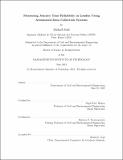Measuring journey time reliability in London using automated data collection systems
Author(s)
Schil, Mickaël (Mickaël René Jerôme)
DownloadFull printable version (10.72Mb)
Other Contributors
Massachusetts Institute of Technology. Dept. of Civil and Environmental Engineering.
Advisor
Nigel H.M. Wilson and Harilaos N. Koutsopoulos.
Terms of use
Metadata
Show full item recordAbstract
Service reliability is critical for both users and operators of transit systems. The rapid spread of Automated Data Collection Systems, such as Automated Fare Collection (AFC) and Automatic Vehicle Location (AVL), provides new sources of information that can be used to measure and assess service reliability. The main objective of this thesis is to develop a set of simple, customer-driven metrics of journey time reliability, that could be useful and meaningful for both customers and operators. The set of metrics are consistent across transit modes (rail and bus networks). The proposed methodology, common to rail and bus systems, consists of (1) an analysis of the journey time distributions at the finest spatial and temporal resolution, the origin-destination pair (O-D) and time period level (customer perspective), (2) the aggregation of the reliability metrics at the line (route) level (operator perspective), and (3) the definition of journey time reliability standards at the O-D pair and time period level, by the identification of a representative "good" journey time distribution (both customer and operator perspective). For fully gated transit systems, like the London Underground, AFC data provides direct travel time measures for every journey from the fare gate at the entry station to the fare gate at the exit station. For non-gated systems, such as many bus networks, no information is available on passengers' arrival times at the origin bus stop. A method that combines AVL and AFC data is proposed to estimate waiting times at stops so that they can be included in the journey time reliability calculation. Furthermore, the method accounts for the multiple overlapping routes that sometimes serve the same O-D pairs. The proposed methodology is tested using the London public transport system as an illustration. The use of the reliability metrics for operators and customers is also discussed, with proposed modifications of the information provided by journey planners.
Description
Thesis (S.M. in Transportation)--Massachusetts Institute of Technology, Dept. of Civil and Environmental Engineering, 2012. This electronic version was submitted by the student author. The certified thesis is available in the Institute Archives and Special Collections. Cataloged from student submitted PDF version of thesis. Includes bibliographical references (p. 161-162).
Date issued
2012Department
Massachusetts Institute of Technology. Department of Civil and Environmental EngineeringPublisher
Massachusetts Institute of Technology
Keywords
Civil and Environmental Engineering.